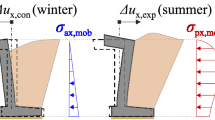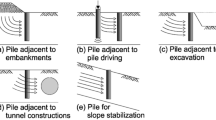Abstract
Barrette is a vital solution to minimize soil displacement problems of massive structures due to its high axial and lateral load capacities. In this paper, a numerical technique for analyzing laterally loaded single barrette previously presented by the authors is extended to analyze barrette groups. The flexibility coefficient is used to determine the soil deformation based on Mindlin’s solution considering the full interaction between barrettes and surrounding soil. Also, it takes into consideration the group interaction of every single barrette on the group of barrettes. A composed coefficient technique is used for condensing the soil stiffness along the barrette surface to be one-dimension along the barrette vertical axis having variable displacements along the barrette height. On the other hand, the barrette in the vertical direction is discretized to one-dimensional finite elements. The soil stiffness is added to the barrette stiffness generating the full stiffness matrix of barrette groups to be solved. As a result, the number of equations is reduced. The present hybrid technique is verified by comparing results from analyzing laterally loaded barrettes multi-layered soil with those obtained analytically in the available literature. The proposed hybrid technique is implemented in well-known software ELPLA. Furthermore, a parametric study is carried out to investigate the behavior of laterally loaded barrette/barrette groups. From this study, for the barrette/barrette group subjected to lateral load with a barrette height/width ratio more than 30, its height does not influence the barrette response.

























Similar content being viewed by others
References
Basu D, Salgado R (2008) Analysis of laterally loaded piles with rectangular cross sections embedded in layered soil. Int J Numer Anal Meth Geomech 32(7):721–744. https://doi.org/10.1002/nag.639
Choi Y, Basu D, Salgado R, Prezzi M (2014) Response of laterally loaded rectangular and circular piles in soils with properties varying with depth. J Geotechn Geoenviron Eng. https://doi.org/10.1061/(ASCE)GT.1943-5606.0001067
El Gendy M (2007) Formulation of a composed coefficient technique for analyzing large piled raft. Ain Shams Eng J 42:29–56
EL Gendy M, El Gendy A, El Gendy O (2018) Analysis of Piled raft of Burj Khalifa in Dubai by the program ELPLA, GEOTEC Software Inc, Canada.
EL Gendy M, EL Gendy A (2020) Analysis and design of raft and piled Raft-Program ELPLA. GEOTEC Software Inc, Canada
EL Gendy M, H Ibrahim, EL Araby I (2016) Analyzing barrettes as large-section supports by CCT. Port-Said Eng Res J 20(2):27–39. https://doi.org/10.21608/pserj.2016.33578
EL Gendy M, H Ibrahim, EL Araby I (2019) Composed coefficient technique for modelling barrette groups. Malaysian J Civil Eng 31(1):23–33. https://doi.org/10.11113/mjce.v31n1.510
EL Gendy M, H Ibrahim, EL Araby I (2020) Analysing rectangular pile using one dimensional finite element. Geotech Geol Eng. https://doi.org/10.1007/s10706-020-01314-5
EL Gendy M, H Ibrahim, EL Araby I (2020) Developing the composed coefficient technique for analyzing laterally loaded barrettes. Innov Infrastruct Solut 5:43. https://doi.org/10.1007/s41062-020-00294-y
Kacprzak G (2015) Proposition of designing method for barrettes as a non-direct foundation of engineering construction. Tech Trans 24:71–77. https://doi.org/10.4467/2353737XCT.15.228.4614
Kumari A, Thakare SW, Dhatrak AI (2020) Lateral and Uplift Capacities of Barrette Pile in Sandy Soil. In: Latha Gali M., Raghuveer Rao P. (eds) Construction in Geotechnical Engineering. Lecture Notes in Civil Engineering,Singapore: Springer. https://doi.org/10.1007/978-981-15-6090-3_15
Leszczynski M (2009) Barretted raft design for high-rise building applying 3D numerical tool. The 17th International Conference on Soil Mechanics and Geotechnical Engineering. Alexandria, Egypt. DOI: https://doi.org/ https://doi.org/10.3233/978-1-60750-031-5-1263
Mansour MM, Fayed AL, Morsi MM (2021) Numerical simulation for the nonlinear behavior of laterally loaded barrettes. Innov Infrastruct Solut 6:26. https://doi.org/10.1007/s41062-020-00392-x
Mindlin D (1936) Force at a point in the interior of a semi-infinite solid. Physics 7(5):195–202. https://doi.org/10.1063/1.1745385
Poulos HG, Chow H, Small JC (2019) The use of equivalent circular piles to model the behaviour of rectangular barrette foundations. Geotech Eng J SEAGS & AGSSEA 50(3):106–109
Rafa S, Moussai B (2018) Three-dimensional analyses of bored pile and barrette load tests subjected to vertical loadings. Soil Mech Found Eng 55(3):146–152. https://doi.org/10.1007/s11204-018-9518-0
Russo G (1998) Numerical analysis of piled rafts. Int J Numer Anal Meth Geomech 22(6):477–493. https://doi.org/10.1002/(SICI)1096-9853(199806)22:6%3C477::AID-NAG931%3E3.0.CO;2-H
Russo G., Viggiani C. (2008). Pile foundations under horizontal load: an overview. Proceedings of the Second BGA International Conference on Foundations, ICOF2008, ISBN 978–1–84806–044–9, No. 3:61–80.
Russo G (2016) A method to compute the non-linear behaviour of piles under horizontal loading. Soils Found 56(1):33–43. https://doi.org/10.1016/j.sandf.2016.01.003
Russo G, Abagnara V, Poulos HG, Small J (2012) Re-assessment of foundation settlements for the Burj Khalifa. Dubai Acta Geotechnica 8(1):3–15. https://doi.org/10.1007/s11440-012-0193-4
Seo H, Basu D, Prezzi M, Salgado R (2009) Load-settlement response of rectangular and circular piles in multilayered soil. J Geotech Geoenviron Eng 135(3):420–430. https://doi.org/10.1061/(ASCE)1090-0241(2009)135:3(420)
Stacul S, Squeglia N, Russo G (2020) PRaFULL A method for the analysis of piled raft foundation under lateral load. Geomech Eng 20(5):433–445. https://doi.org/10.12989/GAE.2020.20.5.433
Zhang L (2003) Behavior of laterally loaded large-section barrettes. J Geotechn Geoenviron Eng 129(7):639–648. https://doi.org/10.1061/(ASCE)1090-0241(2003)129:7(639)
Znamenskii V, Bakholdin V, Parfenov A, Musatova M (2019) Investigation of the load-carrying capacity of barretes for a 56-storey residential building. Soil Mech Found Eng 56(1):1–6. https://doi.org/10.1007/s11204-019-09561-2
Author information
Authors and Affiliations
Corresponding author
Rights and permissions
About this article
Cite this article
El-Gendy, M.M., Ibrahim, H.M.H. & El-Arabi, I.A. The behavior of laterally loaded barrette groups using hybrid flexibility coefficient and finite element technique. Innov. Infrastruct. Solut. 6, 170 (2021). https://doi.org/10.1007/s41062-021-00535-8
Received:
Accepted:
Published:
DOI: https://doi.org/10.1007/s41062-021-00535-8




